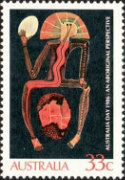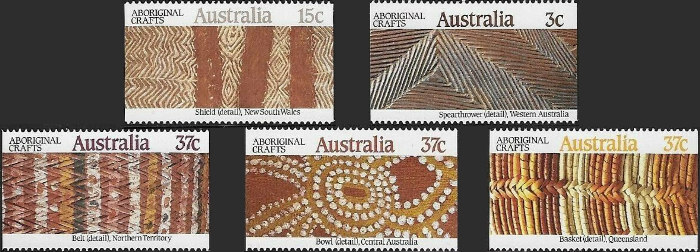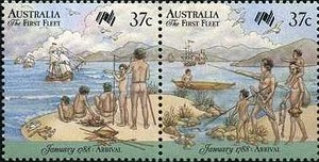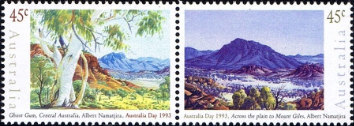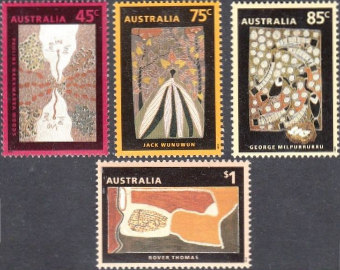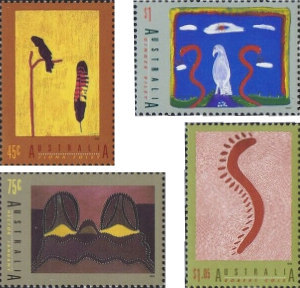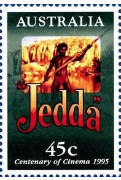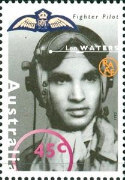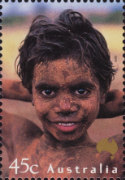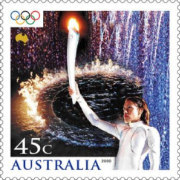Aboriginal timeline: Arts
Found 131 results for your search. Showing page 2 of 7.
1982
-
Australia Post issues a set of four stamps themed Aboriginal Culture in Music and Dance. It is the first time actual Aboriginal work appears on Australian stamps. All designs show bark paintings of Mimi spirits dancing. The artists are David Milaybuma (27c), Lofty Nabardayal (40c), Jimmy Galareya (65c) and Dick Nguleingulei-Murrumurru (75c).

Mimis are fairy-like beings of Arnhem Land (NT) and have extremely thin and elongated bodies. They live in rock crevices and sometimes taunt people.
1984
-
The first stamp issue for the Australian Bicentennial shows Aboriginal rock art. It is interesting to note that the series is titled "First Australians" which only much later was agreed to be one of the appropriate terms for Aboriginal people. The first stamp introduces the bicentennial symbol. Australia Post also published a booklet with detailed explanations of the stamps called The First Australians: Our Heritage in Stamps (Australian Bicentennial Collection).
The designs show stick figures (Cobar Region, NSW), Bunjil's Cave (Grampians, WA), Quirkan Gallery (Cape York, QLD), a Wandjina spirit with snake babies (Gibb River, Kimberley, WA), a rock python (Gibb River), a silver barramundi (Kakadu National Park, Alligator Rivers Area, NT) and a rock possum (Kakadu National Park).


Although the captions use "First Australians" they fail to explain the locations of the rock art, a lost opportunity to raise awareness of this rich cultural heritage.
1986
-

A Wandjina spirit protects the land. This stamp issue shows the continent of Australia cradled and protected by a Wandjina spirit. He holds a second egg in his hand, a symbol of perfection and rebirth. It also refers to the unbroken (and still misunderstood) Aboriginal spirit and how the land owns its people.
1987
-
Australia Post issues a set of 5 stamps with details of Aboriginal crafts. The stamps show patterns on a basket (from Arukun, QLD; 37c), a spear thrower (Warburton River, WA; 3c), a bowl (Pintubi people of Central Australia; 37c); a belt (Arnhem Land, NT; 37c) and a shield (New South Wales; 15c).

Aboriginal people used ochres and grasses of different colours to create the patters seen in their craft.
1988
-

Aboriginal people's reception of the First Fleet was not as passive and peaceful as shown here. Two stamps of the Australia Day issue show an Aboriginal family watching the arrival of the First Fleet. They are relaxed and just looking on, a misrepresentation of the resistance Aboriginal people showed when they first encountered the British.
-
Australia Post issues four stamps celebrating the Art of the Desert. All paintings selected for this issue depict an event in the Dreaming: Bush Potato Country (Turkey Tolsen Tjupurrula & David Corby Tjapaltjarri, 37c), Courtship Rejected (Limpi Puntungka Tjapangati, 55c), Medicine Story (unknown artist, 90c) and Ancestor Dreaming (Tim Leura Tjapaltjarri, $1).

The issue features four stamps from the Flinders University Art Museum that depict an event in the Dreaming.
1992
-
The first Survival Day concert is held in Sydney.
1993
-
To celebrate the International Year of Indigenous People, Australia Post issues two stamps for Australia Day that celebrate Aboriginal painter Albert Namatjira and his watercolour style. The stamps show a ghost gum and Mount Giles.

Albert Namatjira was famous for his use of water colours. -

The common theme of these paintings is 'Dreaming'. Australia Post issues a set of four stamps to celebrate the International Year of Indigenous People showing paintings by Aboriginal artists. They are: Wild Onion Dreaming by Pauline Nakamarra Woods (45c), Yam Plants by Jack Wunuwun (75c), Goose Egg Hunt by George Milpurrurru (85c) and Kalumpiwarra-Ngulalintji by Rover Thomas ($1).
-

This set showcases the work of four different Aboriginal artists. A second set of stamps celebrates the International Year of Indigenous People with the designs for this issue based on four Aboriginal artists' work: Black Cockatoo Feather by Fiona Foley (45c), Ngarrgooroon Country by Hector Jandany (75c), Ngak Ngak by Ginger Riley Munduwalawala ($1) and Untiled by Robert Cole ($1.05).
-

In a first for Vogue, Aboriginal model Elaine George of Brisbane becomes the cover girl for the September issue of Vogue Australia 1993, leading to a career as an international model. Elaine, a descendant from the Arakwal people of Byron Bay, was discovered as a 17-year-old at Dreamworld, a Gold Coast amusement park, by freelance photographer Grant Good. The issue became the highest selling Vogue in the then 34-year history of Australian Vogue.
1995
-

Jedda was the first Australian feature to employ Aboriginal lead actors. One stamp in the Centenary of Cinema issue features Jedda – the first Australian feature film to use Aboriginal actors in the lead roles and the first to be filmed in colour.
-

Len Waters was a fighter pilot for the RAAF. Streets in ACT and Sydney bear his name. In its second Australia Remembers issue, Australia Post features Len Waters who became the first Aboriginal military pilot accepted into the Royal Australian Air Force and the only Aboriginal fighter pilot to serve during World War II.
1996
-
Richard Frankland becomes the first Aboriginal director to win an AFI Award for his documentary No Way To Forget.
1997
-
The stamps in this issue are images from four animations of The Dreaming series, a video series of 13 animated stories for children, released by the Australian Film Commission in 1995 and 1997.
The images show Dumbi the owl (based on a story by David Mowaljarlai of the Hibiscus people), The Two Willy-Willies (a story told by Josie Boyle from the desert people of the Wongi nation), How Brolga Became a Bird (a story told by Pauline McLeod from the Mutti Mutti people of Lake Mungo, NSW) and Tuggan Tuggan (Silky Oak) (a story told by Oodgeroo Noonuccal from Stradbroke Island).

Left to right: Dumbi the Owl; The Two Willy-Willies; How Brolga Became an Owl; Tuggan Tuggan.
1999
-
16-year-old Daniel Walbidi, from Yulparija, walks into Broome’s Short Street Gallery and asks owner Emily Rohr for painting supplies, inspiring his Yulparija elders, aged in their 70s and 80s, to start painting the stories of their ancestral desert lands they had left more than 40 years prior, and thus sparking an art movement. He went on to become one of Australia’s finest contemporary artists.
-
Jimmy Little is inducted into the Hall of Fame of the Australian Recording Industry Association (ARIA) Music Awards.
2000
-

Portrait of young Cyril Watson. One of the 25 unique photographs of Australians from everyday life in the Faces of Australia issue is Cyril Watson, a young girl from remote Central Australia.
-

Stamp commemorating Cathy Freeman's win over 400m. Australia Post's Australian Gold Medallists issue shows the first stamp of a living Aboriginal person. Until 1997 no living person (Royal family excluded) was featured on Australia’s stamps. Athlete Cathy Freeman is the only Aboriginal person who has been individually honoured on a stamp in such a way.
-

The 45c stamp featured Cathy Freeman holding the Olympic torch. This stamp issue features Cathy Freeman lighting the Olympic Flame at the opening ceremony of the XXVII (27th) Olympic Games in Sydney. The stamp was voted the most popular in the 2000 Australia Post Stamp Poll.



